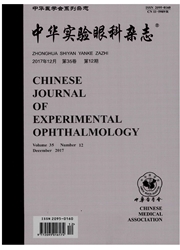

 中文摘要:
中文摘要:
目的观察正常大鼠视觉发育关键期内双脉冲刺激诱导的视皮层Ⅱ或Ⅲ层锥体神经元兴奋性突触后电流(EPSC)-抑制性突触后电流(IPSC)随发育改变的特征及其相互关系,探讨短时程突触可塑性在大鼠视觉发育关键期突触可塑性变化中的作用。方法实验研究。取健康Wistar大鼠30只,抽签法随机分为A组(生后10~12d)、B组(生后14~16d)、C组(生后21~23d)、D组(生后28~30d)、E组(生后35~37d),每组6只。采用脑片膜片钳全细胞记录技术,将全细胞记录膜电位分别钳制在一50mV、0mV从而电学分离出EPSC和IPSC,以双脉冲系数为观测指标,分析不同天龄组双脉冲刺激(刺激间隔40ms)诱导的EPSC、IPSC发育特征。多组样本比较采用单因素方差分析,多样本均数比较采用Bonferronit检验。结果A~E组大鼠视皮层Ⅱ或Ⅲ层锥体神经元EPSC双脉冲系数分别为0.43±0.08、0.07±0.08、0.10±0.10、0.20±0.07、0.22±0.12,其中睁眼初期即B组双脉冲系数值减小,较睁眼前差异有统计学意义(t=-3.13,P=0.04)。相应组大鼠视皮层Ⅱ或Ⅲ层锥体神经元IPSC双脉冲系数分别为0.6036±0.3021、0.2830±0.0504、0.0287±0.0907、-0.0449±0.1443、-0.3089±0.0553,视觉发育关键期内,随年龄增长IPSC的双脉冲系数逐渐降低(F=5.0799.P=0.0037),且从D组始由正开始转为负数,由双脉冲增强转为双脉冲压抑。结论兴奋性突触后电流对视觉刺激反应迅速,但在视觉发育关键期(生后19~32d)变化不明显;抑制性突触后电流从睁眼开始至视觉发育关键期结束短时程压抑逐渐增强,其在视皮层Ⅱ或Ⅲ层锥体神经元成熟及视觉发育关键期结束过程可能起到更加重要的作用。
 英文摘要:
英文摘要:
Objective To observe the characters of EPSC-IPSC induced by paired-pulse stimulation of rat visual cortex layer Ⅱ/ Ⅲ pyramidal neurons during critical period of visual development, and discuss their relationships, to discuss the role of short-term synaptie plasticity in the critical period of visual development of rats. Methods Thirty Wistar rats were used,they were divided into P10-P12, P14-P16, P21-P23, P28-P30, P35-P37 five groups,n = 6. Whole-cell voltage clamp recording was performed, the membrane potential was clamped on -50 mV, 0 mV respectively to separate EPSC and IPSC. We set the PPR as the observation indicator, analyzed the developmental features of EPSC and IPSC induced by pairedpulse stimulation of different groups. Results The PPR of layer Ⅱ/ Ⅲ pyramidal neurons in group P10- P12, P14-P16, P21-P23, P28-P30, P35-P37 was 0. 43 ± 0. 08, 0. 07 ±0. 08, 0. 10 ± 0. 10, 0. 20 ± 0. 07, 0. 22±0. 12 respectively. The PPR of group P14-P16 decreased, the difference was statistically significant compared with the group before eyes open( t = -3.13 ,P = 0. 04). The PPR of corresponding groups was 0.6036±0.3021, 0.2830 ±0.0504, 0.0287 ±0.0907, -0.0449 ±0.1443, -0.3089 ±0.05553 respectively(F =5. 0799,P = 0. 0037 ), the PPR of IPSC gradually reduced with age, and turned negative from the P28-P30 group, changed from PPF to PPD. Conclusions The PPR of EPSC response to visual stimuli rapidly, but did not change significantly in the critical period of visual development (P19 - P32 ). The short-term depression of IPSC increased gradually from the eyes open to the end of the critical period of visual development, which may play a more important role in the process of layer Ⅱ/ Ⅲ pyramidal neurons maturation and the critical period of visual development ending.
 同期刊论文项目
同期刊论文项目
 同项目期刊论文
同项目期刊论文
 Synaptic Modifications In Neurons Of Rat Visual Cortex Induced By Correlated Subthreshold Pre- And P
Synaptic Modifications In Neurons Of Rat Visual Cortex Induced By Correlated Subthreshold Pre- And P 期刊信息
期刊信息
